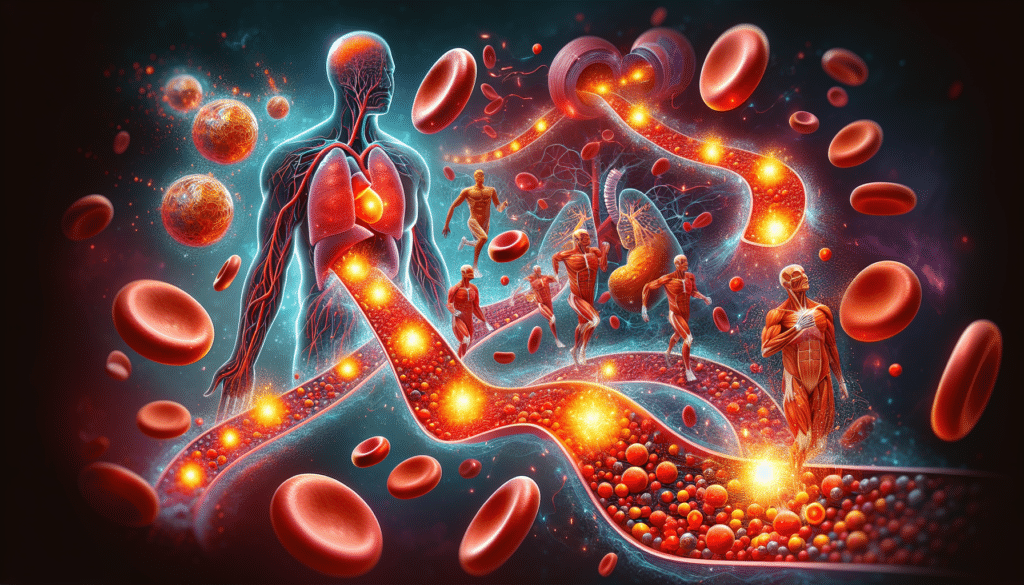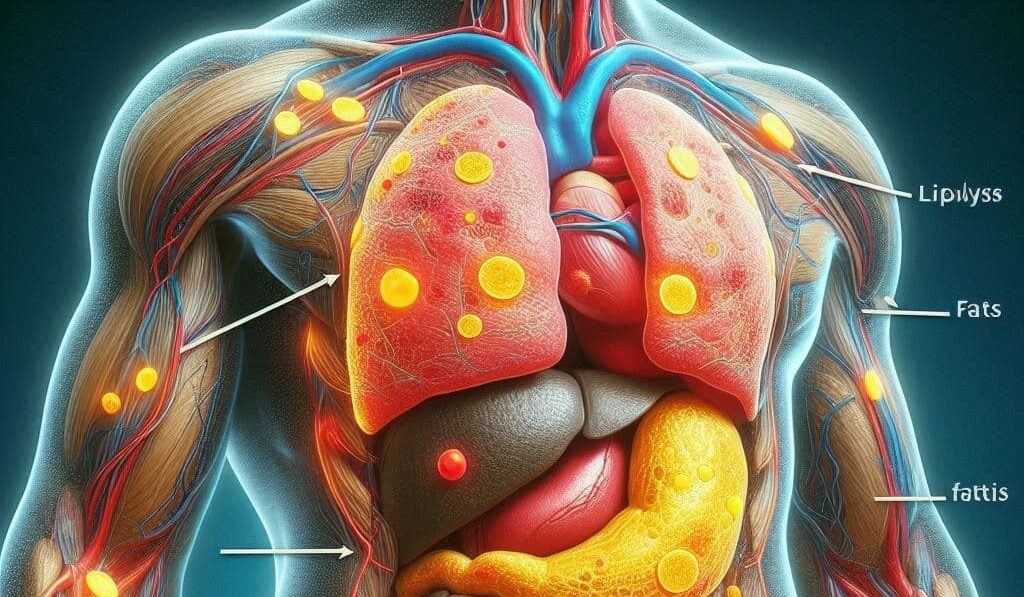Top Strategies for Fat Loss: The Science of Burning Fat
How does your body burn fat? Understanding the science is critical. This article breaks down fat metabolism, explains the processes involved, and offers tips to optimize fat burning. Learn how diet, exercise, and other factors influence your body’s ability to shed fat. Discover the science of burning fat and how to use it to meet your goals.
Key Takeaways
Understanding fat metabolism processes and how the body stores and uses fat is crucial for developing effective weight loss strategies.
Reducing calorie intake to create a deficit and incorporating aerobic and resistance exercises can significantly enhance fat burning.
Sufficient sleep, a healthy gut microbiome, and tailored diet and exercise approaches based on gender differences are essential for sustainable fat loss.
Understanding Fat Metabolism

Grasping the concept of fat metabolism is critical to effective weight loss and healthy weight maintenance. This process involves the complex breakdown and synthesis of fatty acids for energy and storage.
Fatty acids and glycerol are produced through lipolysis, where triglycerides in fat cells are decomposed. These components are then released into the bloodstream, supplying energy to muscles, the heart, and other organs.
Once in the bloodstream, these free fatty acids undergo oxidation. Through a process known as β-oxidation, fatty acids are converted into acetyl CoA, which enters the Krebs cycle to produce energy. This complex procedure guarantees efficient energy harnessing from stored fat, significantly when food intake dwindles or during extended physical activities.
Fat metabolism is not just about breaking down fat for energy but also involves storing excess energy. Lipogenesis is the process by which excess acetyl CoA is converted into fatty acids and triglycerides. These are then stored in adipose tissue for future use. This dual functionality of fat metabolism – breaking down fat for energy and storing excess energy – is crucial for maintaining a balance in body composition.
Another essential aspect of fat metabolism is the transport of triglycerides and cholesterol via chylomicrons. These lipoprotein particles shuttle lipids through the lymphatic and circulatory systems to various tissues, including adipose tissue, where they are stored. This system ensures energy is available where and when needed, maintaining homeostasis.
Comprehending these processes aids in formulating strategies for effective weight loss. Knowing how the body stores and uses fat can manipulate dietary intake and physical activity to enhance fat burning. This knowledge is fundamental for anyone looking to lose body fat and achieve a healthy body weight.
How the Body Burns Fat

The human body exhibits an exceptional capacity to store energy as body fat, primarily housed in adipocytes or fat cells. These cells are loaded with triglycerides, which serve as long-term energy reserves. When the body requires energy, such as during exercise, the brain signals these fat cells to release fatty acids into the bloodstream. This process is essential for maintaining energy during increased physical activity.
After release, these fatty acids journey to different tissues like muscles, lungs, and the heart, serving as a source of energy production. The byproducts of this fat-burning process are water and carbon dioxide, which are expelled from the body through respiration and urine. Over time, as the body continues to utilize these fatty acids, the number and size of fat cells decrease, reducing body fat and improving overall metabolism.
Physical activity is pivotal in this process. The demand for energy increases significantly during physical activity, especially aerobic exercises. This heightened energy requirement prompts the body to tap into fat stores, accelerating fat burning. Regular exercise helps burn fat and improves blood flow, which enhances the delivery of fatty acids to the tissues that need them the most.
Bear in mind that the body doesn’t regenerate lost fat cells. Instead, it absorbs and discards the empty cells, which can lead to a lasting reduction in fat stores. This highlights the importance of maintaining an exercise schedule and a balanced diet to ensure the body burns fat efficiently.
Understanding how the body burns fat can empower individuals to make reasonable decisions about their exercise routines and diet. Focusing on activities and nutritional strategies that enhance fat oxidation can help achieve more effective and sustainable weight loss.
The Role of Caloric Deficit in Fat Loss
The principle of caloric deficit forms the foundation of any effective weight loss strategy. This concept is based on the simple yet powerful idea that one must consume fewer calories than the body expends to lose weight. When the body is in a caloric deficit, it turns to stored fat to meet its energy needs, leading to fat loss.
Creating a caloric deficit can be achieved in two primary ways: cutting down calorie consumption or ramping up physical activity. Reducing calorie intake can be achieved by making healthier choices, such as choosing nutrient-dense foods that provide essential minerals and vitamins without excessive calories. On the other hand, increasing physical activity can help burn more calories, further contributing to the caloric deficit.
A proposed method for healthy weight loss involves a gradual daily reduction of 250 to 500 calories. This can result in losing around 1 to 2 pounds per week, which health authorities like the CDC consider safe and sustainable. Losing weight quickly is often not sustainable, making maintaining weight loss over time challenging due to muscle loss and a slower metabolism.
As weight loss progresses, it may be necessary to change your calorie intake further to continue losing weight. This is because the body’s energy needs decrease as body weight decreases. Women, in particular, may need to consume between 1,200 and 1,800 calories a day to lose weight, depending on age, current weight, and activity level.
Crafting a caloric deficit goes beyond merely slashing calories. It’s crucial to focus on the quality of the calories consumed. Nutrient-dense foods high in protein and fiber can help preserve muscle mass and promote satiety, making it more straightforward to stick to a reduced-calorie diet. Combining a caloric deficit with regular physical activity is crucial to achieving and maintaining successful weight loss.
Types of Exercise That Promote Fat Burning

Not all exercises yield the same fat-burning results. Combining cardiovascular exercises with strength training is deemed ideal for optimizing fat loss. These activities burn calories during the workout and enhance the body’s metabolism, leading to continued fat-burning after the exercise session.
Including both high-intensity interval training (HIIT) and resistance training in your workout routine can provide an extra boost for fat burning. Each type of exercise has its benefits and can be customized to individual fitness levels. We’ll delve into these exercises in more detail.
High-Intensity Interval Training (HIIT)
High-Intensity Interval Training (HIIT) is renowned for its effectiveness in burning fat. This type of exercise includes short bursts of intense exercise followed by intervals of rest or low-intensity exercise.
HIIT burns a significant amount of calories during the workout and boosts metabolism, leading to continued calorie burn after the session has ended. This occurrence, known as the afterburn effect or excess post-exercise oxygen consumption, ensures that the body burns calories at an increased rate even while at rest.
A typical HIIT session can include sprinting, cycling, or bodyweight exercises performed at maximum effort for 20 to 25 seconds, followed by a brief recovery period. The high intensity of these workouts challenges the body’s energy systems, promoting greater fat oxidation and improving overall fitness. Studies have shown that HIIT can lead to superior abdominal fat loss compared to moderate-intensity exercise, making it an excellent choice for those looking to reduce belly fat.
Adding HIIT to your workout regimen can significantly enhance fat loss. Its combination of high-calorie burn, increased metabolism, and enhanced fat oxidation makes it one of the most effective strategies for burning fat and improving body composition.
Resistance Training
Resistance or strength training is crucial in promoting fat loss and muscle retention. This exercise involves using resistance bands or weights to perform movements that build and strengthen muscle tissue. More muscle mass increases the fat burned at rest, enhancing overall metabolism.
The principle of progressive overload is critical to achieving results with resistance training. This entails gradually increasing the weight or doing resistance exercises to challenge the muscles continuously. As muscle mass grows, the body burns more calories, even at rest, leading to more significant weight loss.
Integrating resistance training into your fitness schedule can also improve muscle strength and metabolic rate, contributing to more effective weight management. The Cleveland Clinic suggests at least 30 minutes of resistance training twice weekly. This can help boost muscle mass and promote fat loss.
By combining resistance training with other forms of exercise, you can create a well-rounded workout plan that maximizes fat-burning and supports overall health.
Moderate Intensity Exercise
Moderate-intensity exercises, such as jogging, cycling, and brisk walking, are practical for burning fat over longer sessions. These activities can be maintained for extended periods, making them ideal for those looking to incorporate steady cardio into their routine. During moderate-intensity exercise, the body predominantly uses fat as an energy source, which can directly lead to significant fat loss over time.
One critical benefit of moderate-intensity exercise is its accessibility. People of all fitness levels can perform these activities, and they do not require any special equipment. Additionally, moderate-intensity exercise can be easily integrated into daily life, such as commuting by bike or walking briskly during lunch breaks.
Regular moderate-intensity exercise can improve cardiovascular health, enhance endurance, and promote overall well-being. By incorporating exercises into your fitness routine, you can create a balanced fat-burning approach that supports long-term weight management and health goals.
Nutrient Timing for Optimal Fat Loss

Nutrient timing involves consuming specific nutrients at designated times and can profoundly influence fat loss. One effective strategy is to consume carbohydrates after exercise. Following a workout, the body’s carbohydrate tolerance is at its highest, making it the ideal time to replenish muscle glycogen stores with fast-digesting carbs. Consuming a carbohydrate-rich snack within 30 minutes of exercise can maximize muscle recovery and enhance overall performance.
Conversely, consuming a low-carb, high-protein meal before exercise can encourage the body to use fatty acids as fuel, promoting greater fat oxidation during the workout. Protein is essential in fat loss by stimulating growth hormone release and maintaining an elevated metabolic rate. Foods with a lot of protein, such as lean meats, dairy products, and eggs, can help support muscle growth and fat burning.
Conversely, skipping meals can be counterproductive to fat loss efforts. It often leads to overeating later and can slow down metabolism. Instead, focusing on nutrient-dense foods and healthy snacks like vegetables, fruits, and nuts can help control hunger and prevent overeating. By strategically timing nutrient intake, you can optimize your body’s capability to burn fat and achieve weight loss goals.
Importance of Sleep in Fat Loss

Sufficient sleep, while crucial, needs to be more frequently addressed in fat loss discussions. Proper sleep helps regulate metabolism, immune function, and stress management, which is essential for maintaining a healthy body weight.
When sleep-deprived, individuals are more likely to crave high-calorie, high-carbohydrate foods, leading to overconsumption and weight gain. Additionally, the lack of sleep can cause the body to store fat rather than burn it, hindering weight loss efforts. Ensuring adequate sleep can help maintain optimal metabolism and regulate appetite, making sticking to a healthy diet and exercise routine less challenging.
Aim for eight hours of sleep daily to support fat loss. Having a regular sleep schedule, developing a relaxing bedtime routine, and minimizing exposure to screens before bed can all improve sleep quality. By prioritizing sleep, you can enhance your body’s capability to burn fat and achieve weight loss goals.
Gut Health and Its Impact on Fat Burning
Gut health significantly contributes to fat burning and overall weight management. A healthy gut microbiome, characterized by a diverse range of microorganisms, can influence how the body absorbs calories from food and regulates metabolism. Research suggests that individuals with obesity often have a lower gut microbiome compared to those with moderate weight, which can negatively impact gut health and weight management.
Certain gut bacteria, such as those from the Prevotella group, are associated with more effortless weight loss and body fat reduction. In contrast, an imbalance of ‘bad’ gut bacteria can increase weight and belly fat. Maintaining a diverse and balanced gut can support fat-burning and overall health.
To promote a healthy gut, focus on a diet rich in probiotics, fiber, and prebiotics. Foods such as fruits, vegetables, yogurt, and fermented products can help nourish beneficial gut bacteria and support gut health. By prioritizing gut health, you can enhance your body’s ability to burn fat and achieve a healthy body weight.
Differences in Fat Loss Between Men and Women
Due to differing genetic, hormonal, and physiological factors, men and women experience fat loss in unique ways. Testosterone, a hormone found in men, promotes the growth of lean muscle tissue, making it easier for men to lose fat. This hormonal advantage allows men to lose weight more quickly and efficiently than women, who might work harder to achieve similar results.
The fat distribution also varies between genders. Men tend to build up fat in the upper body, leading to an ‘apple’ shape, while women often store fat in the lower body, resulting in a ‘pear’ shape. This difference is influenced by hormones like estrogen, which directs fat storage in the hips and thighs of premenopausal women. After menopause, women may experience a shift towards abdominal fat accumulation due to changes in hormone levels.
Understanding these differences can help tailor weight loss strategies to individual needs. Women may benefit from focusing on exercises that target the lower body and incorporating more high-intensity interval training to boost fat loss. Conversely, men can leverage their higher muscle mass to engage in more strength training, enhancing their fat-burning potential.
Common Myths About Fat Burning
Numerous myths circulate regarding fat burning. One of the most common misconceptions is the idea of targeted fat loss or spot reduction. Many believe exercising a specific body part will reduce fat in that area, but science tells us otherwise. Fat loss happens throughout the body, not just in exercise areas.
Another myth is that eliminating entire food groups is necessary for weight loss. Doing this can lead to nutrient deficiencies and needs to be more sustainable in the long term. Eating foods that include a variety of foods is crucial for providing the nutrients needed for overall health and effective fat loss.
There is also the false belief that certain foods or supplements can magically burn fat. While some foods can boost metabolism slightly, no food or supplement can replace the fundamental need for a caloric deficit and regular exercise. Understanding these truths can help individuals focus on practical, evidence-based strategies for achieving their weight loss goals.
Measuring Progress in Fat Loss
Measuring fat loss progress entails more than merely stepping on the scale. Various tools and methods provide a more comprehensive understanding of changes in body composition. For instance, body fat calipers measure the thickness of fat deposits under the skin at specific sites, offering a simple and cost-effective way to estimate body fat percentage.
Dual-energy X-ray Absorptiometry (DXA) scans are considered the gold standard in body composition analysis. They provide detailed insights into bone density, fat, and muscle mass, helping individuals understand where they lose and gain muscle. Another method, hydrostatic weighing, assesses body composition by measuring body density through underwater weighing, offering accurate results for those seeking precise measurements.
Bioelectrical impedance analysis is another popular tool. It estimates body composition by sending electrical currents through the body and measuring resistance. Each method has pros and cons, but they provide a robust picture of fat loss progress, helping individuals stay motivated and adjust their strategies as needed. Reviewing and analyzing these methods can further enhance our understanding of their accuracy and effectiveness in tracking body composition changes.
Summary
In summary, achieving fat loss involves a multifaceted approach that includes understanding fat metabolism, creating a caloric deficit, engaging in various types of exercise, and paying attention to nutrient timing. Adequate sleep and maintaining gut health are crucial in optimizing fat burning. Additionally, recognizing the differences in fat loss between men and women can help tailor individual strategies for more effective results.
Individuals can stay informed and motivated on their weight loss journey by debunking common myths and using reliable methods to measure progress. Fat loss is not about quick fixes but about making consistent, healthy choices that lead to lasting results. Stay committed, stay informed, and the results will follow.
Frequently Asked Questions
Can I lose fat from specific body areas by targeting them with exercises?
No, targeting specific areas with exercises does not lead to fat loss in those areas. Fat loss occurs throughout the body, not just in the targeted areas.
Is it necessary to eliminate entire food groups to lose weight?
You do not have to eliminate entire food groups to lose weight. It’s crucial for effective fat loss to eat a variety of foods.
How many calories should I cut to lose weight?
You should cut your daily calories by 250 to 500 for a safe weight loss rate of 1 to 2 pounds per week.
What is the best type of exercise for burning fat?
The best exercise for burning fat combines high-intensity interval training (HIIT), resistance training, and moderate-intensity exercise, which maximizes fat loss.
How important is sleep for fat loss?
Sleeping is vital for fat loss as it regulates metabolism, appetite, and stress levels. Lacking sleep can lead to weight gain and difficulty losing weight.



